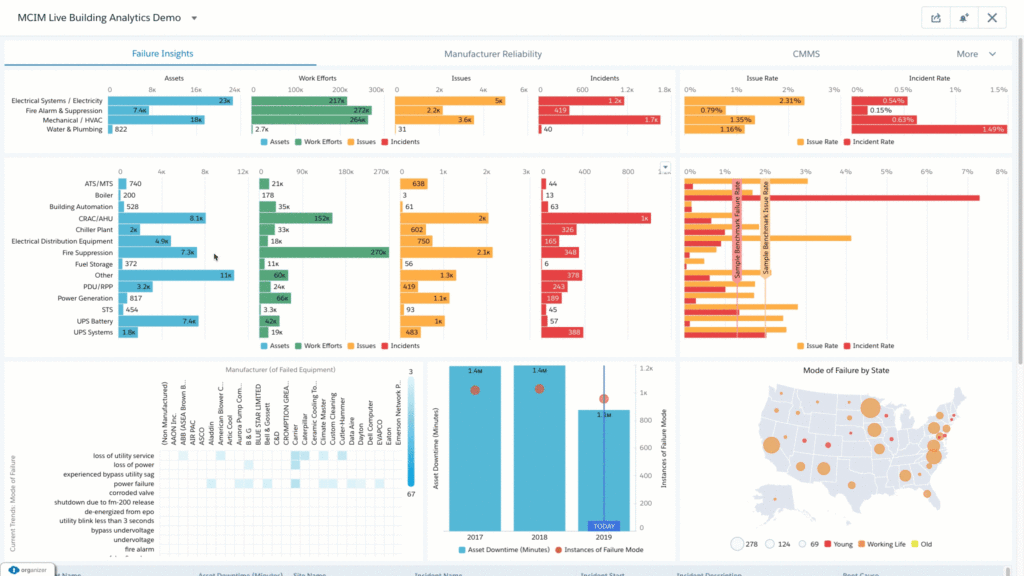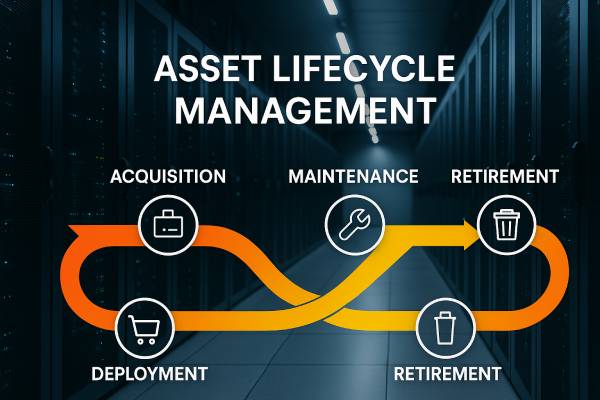Updated on May 9th, 2024
Whether you’re overseeing data centers or commercial real estate buildings, a comprehensive and holistic view of your total portfolio is key to efficient facility management. But all of the data in the world isn’t going to help if you can’t read it.
That’s where data visualization and interactive dashboards create massive value and business intelligence. Reporting dashboards transform data into value, from a portfolio-wide single pane of glass view down to visualizing data around a single asset.
Having your portfolio information available in a format that focuses on your key performance indicators (KPIs) and is easy to digest increases your Business Intelligence (BI) and empowers your strategic initiatives, saving you time and money and changing the way you do business.
What is a Dashboard?
Dashboards organize and consolidate a lot of data from your facility management software (FMS) or your enterprise asset management (EAM) system so executives and managers can see the most important information quickly and easily. Having an at-a-glance view of charts and graphs that measure KPIs give your stakeholders and management team the business intelligence to make efficient decisions day-to-day and long term.
The right KPI dashboards transform the way you make key decisions. Here’s some of the ways they help:
- Simplify complex data – present your data in an easy-to-understand format, it’s easier for you to identify trends, patterns and insights
- Improve data visibility – with real-time access to data, dashboards enable you to monitor performance and track progress toward goals
- Facilitate data-driven decisions – elevate important KPIs and other metrics so you can make data-driven decisions quickly and effectively
- Provide actionable insights – with your facility management software data right at your fingertips, you can optimize business processes, improve efficiencies, and drive growth.
What is a Maintenance KPI?
KPIs measure the performance of a person, project, or company and how effective they are at achieving their goals. For facility management and maintenance, your KPIs measure how well you are achieving your goals such as cutting costs or reducing downtime.
KPIs are measurable, quantifiable goals that build into your business’s larger objectives. For example, if your company is seeking to reduce downtime you’ll attach numbers to the goal. These are your KPIs and can be as simple as saying “you’ll reduce downtime by 20%.
KPI vs Metrics
While KPIs are strategic measurements of performance based on key business goals, metrics are lower-level indicators of performance or progress for certain activities. KPIs are strategic while metrics are often tactical.
Important KPIs in Data Center Operations
Knowing how you’re performing and how well you match up with the larger business goals lets you identify and correct any gaps. Using your facility management software to display the right KPI dashboards can help you see and address those gaps quickly, making your efforts more efficient and cost effective.
While there are many KPIs companies use to measure success, some key KPIs for facility maintenance management include:
- Reactive vs. planned and predictive maintenance
- Asset performance
- Downtime
- Site assessment and inspection progress
- Cost vs. budget
Dashboards highlighting the KPIs and metrics that are important to your company can make a huge difference in time, effort, and frustration.
Key KPI Dashboards You Should Be Using In Facility Management
With so much data it can be hard to know where to start. Below are five key dashboards that will help you do more with your data and make better decisions right away:
- Asset Registry Dashboard
- Work Orders and Predictive Maintenance Dashboard
- Reporting of Global Incidents Dashboard
- Site Assessments Dashboard
- Risks and Opportunities Dashboard
Asset Registry Dashboard
Too many businesses still use Excel spreadsheets to keep track of their assets. Yet for many who have embraced software solutions like a Computerized Maintenance Management System (CMMS), Facility Management Software, or Enterprise Asset Management (EAM) System, the asset registry may be populated, but might as well be a spreadsheet for all the insights they can’t provide.

An Asset Registry Dashboard provides you a complete view of your total portfolio, giving you real-time, immediate insights on all of your assets in an easy-to-read format. Drill down from total portfolio view to a region, site, floor, or even a single asset to see specific data such as:
- Asset status
- Rounds and maintenance history including repairs and downtime
- Guides and manuals
- Estimated life expectancy and end-of-life
- Manufacturer historical performance
- Replacement costs
This digital twin, a virtual list of all of your assets, gives you greater visibility across your entire portfolio, giving you the information you need to boost your asset management and operational efficiency into high gear. And with the right cloud-based system, you can have access to all of that data in the field while conducting rounds or performing maintenance and repairs.
So you’ve got a complete view of your entire facility management portfolio of assets across all of your sites being fed real-time with information from rounds and field services – now what?
Work Orders and Predictive Maintenance Dashboard
Predictive maintenance allows you to reduce or eliminate unscheduled downtime caused by equipment or system failures, reduce labor and maintenance costs, and increase the lifespan of your assets.

With a Work Orders and Predictive Maintenance Dashboard, you boost your work order management as you monitor the progress of planned and ad hoc maintenance every step of the way and see your business changing in real time.
Get a quick view of :
- Issues
- Incidents
- Mode of failure
- Manufacturer and provider reliability
- Number of work orders and service requests completed
- Average time to complete a work order or service request
Seeing what proportion of your work is reactive lets you set preventative maintenance workflows that will streamline your upkeep processes and reduce your operational costs. Using a facility management system that digitizes your approval procedure and automates the creation of work orders based on predetermined assessment response criteria puts your data to work for you, easing the process and helping you stay ahead of any issues.
Reporting of Global Incidents Dashboard
According to Uptime Institute, more than 60% of failures result in at least $100,000 in total losses – with 15% costing upwards of $1 million. Using your data to identify trends and get ahead of breakdowns is key to meeting your facility management KPIs.

With a Reporting of Global Incidents Dashboard, you see how the assets across your sites have been functioning and how often you’ve faced downtime. Easily view recent trends and incident data including duration and resolution.
Track incidents and downtime by location with a map displaying hotspots across your entire portfolio. With a click you can drill down to see downtime by asset and by asset criticality.
What kind of incident, when they occurred, how much of an impact they had, and historical data and trends are all at your fingertips.
You will spot problem areas and see root cause analysis at a glance and use automations to generate incident reports and notifications based on out-of-tolerance readings, getting ahead of any failures with preventative maintenance.
Site and Site Assessments Dashboard
If you’re overseeing multiple sites, being able to drill down into a view for each of those sites is vital.

Utilizing a Site and Site Assessments dashboard, you can get a comprehensive view on the condition of each site, complete with assessment progress, trends and hotspots.
This degree of building management lets you track assessment and inspection progress for each site, see how each location is operating, where you can build efficiencies, and where you should commit the most attention. Elevate key questions and answers from your assessments to get more information right away.
Now you can utilize that facility data directly into your capital planning efforts with a 1-click drill-down that allows you to isolate the areas and categories that require the most attention.
Risk and Opportunity Dashboard
Your ability to manage risks and capitalize on opportunities could be the difference between your success or your competitor’s. Being able to identify both and act on them quickly is key.

That’s where the Risk and Opportunity dashboard comes in. Harnessing your facility management software to gain a quick view at your portfolio’s risks and opportunities, you can identify each immediately and inform your team to act quickly. And with the right system, you can automate the process from the beginning to the end of a repair or replacement.
Couple this with a real-time view of your capital plan with a roll-up of “cost to address” figures and you can see how well you’re aligned to budget any time, what you need to plan for, and where you need to focus not just today but for months to come.
Summary
KPIs are the roadmap to gaps in your facility management operations. Having the right dashboards to view them at a glance helps you respond faster to your company’s needs and goals.
If you need greater insight into your facilities and assets, MCIM by Fulcrum Collaborations provides greater insights and cleaner data all in one single-pane-of glass operating system. Speak with an expert to find out more.



